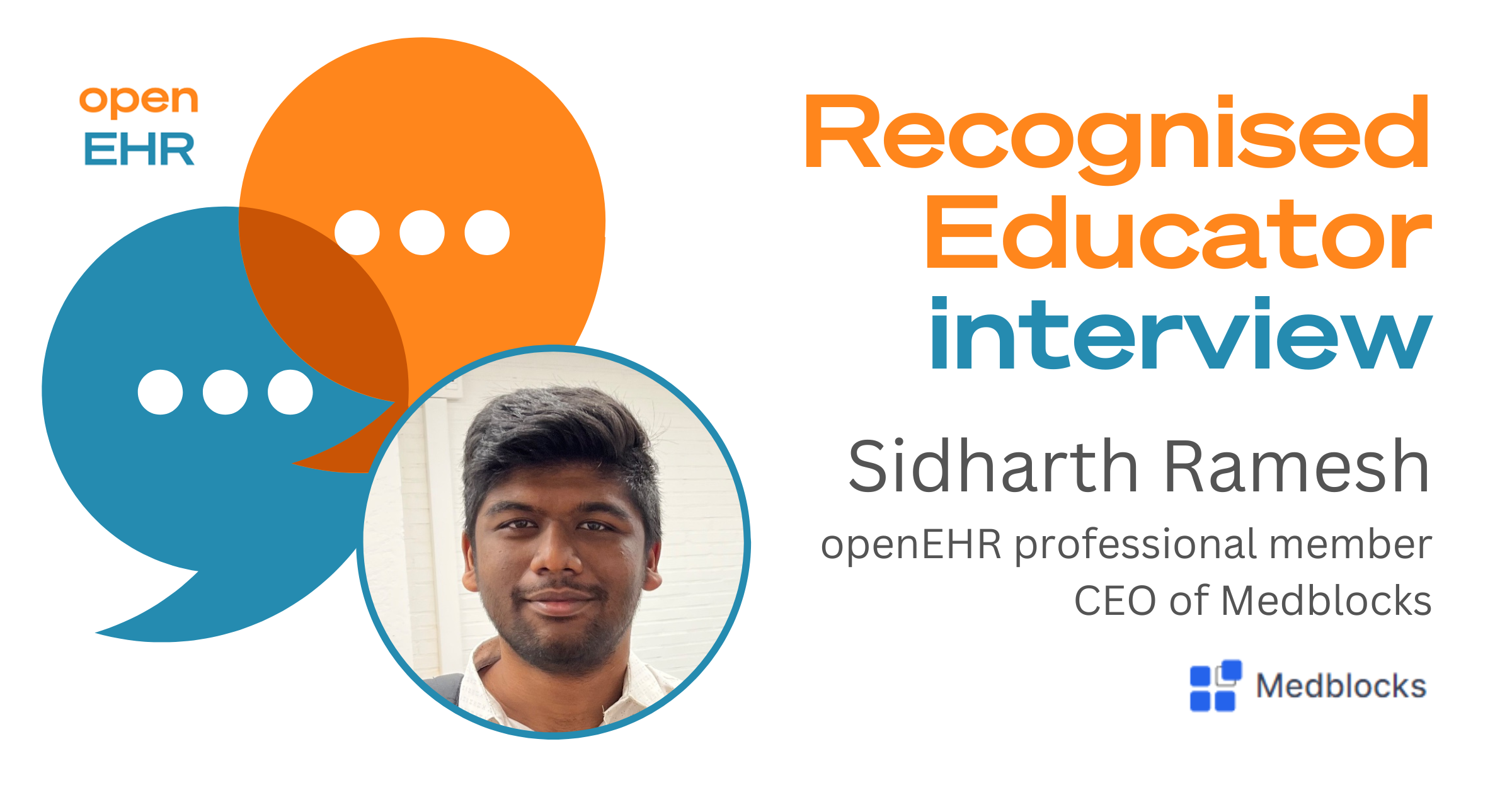Sidharth Ramesh, CEO of Medblocks is our next Professional Member to become a Recognised openEHR Educator. Sidharth chatted to us about his work, business and the importance of openEHR education.
Tell us more about Medblocks and your introduction to openEHR
We started the business about five years ago and now we’re a team of ten, working remotely throughout India. Many of us are doctors but there’s a shared passion for programming within our team and we identify ourselves as a clinical informatics company, with our primary focus directed towards clinical workflows.
The openEHR specification is quite fascinating. I saw that it filed a niche that wasn’t really being solved by other standards, especially with structured clinical data. When working with data, establishing a solid structure and adhering to proper standards is essential before effectively leveraging that data, and this is where my introduction to openEHR came into play. It was evident that the ecosystem surrounding it was in its early stages: even today it’s very nascent when you compare it to established frameworks like FHIR or SNOMED CT. But early on, we recognised the necessity of providing tools that would simplify the understanding of the standard and facilitate the development of applications built upon openEHR.
One of our earliest contributions was the creation of Medblocks UI, an open-source UI library designed for building openEHR based applications easily and quickly. Even now, we still use it in our company to serve our own clients.
Is openEHR the basis for all of MedBlocks’ operations?
We rely on other open-source implementations, such as EHRBase and HAPI FHIR. These implementations serve as the foundation for most of our deployments, and openEHR is the direction we’ve chosen for clinical data. We exclusively store clinical data in the native openEHR format. We use FHIR for demographics data: things like patients, encounters, practitioners. Moreover, in specific regions like India, and the US there’s a distinct FHIR profile to work with, making translating from openEHR to FHIR a more viable option than natively storing clinical data in FHIR.
So our stack runs on a FHIR server and an openEHR server, both vendor neutral. The interesting aspect is that we don’t really care who provides the APIs. You can plug and play with Google, Azure or AWS FHIR APIs.. The same applies to openEHR. Although we are currently using EHRBase, the flexibility exists to interoperate with other systems like Better or Vitagroup’s HIP CDR . This adaptability defines our plug-and-play approach. And depending on the FHIR profile of a particular country, we then push data from the clinical data repository into the FHIR server, based on that particular profile.
Why did you apply to become an openEHR Recognised Educator?
I wanted to make it easier for people to understand and get started with openEHR so I started making educational content in the form of YouTube videos and I freely shared them with the public. I think that’s how people started to recognise our work. As time went on, I noticed that there was a lot of interest from people who wanted to understand the concepts with hands-on activities and tasks to enhance their learning.
So we developed a course – before the Educator Program! Initially, we made the course exclusively available to our partners and clients, but eventually, we decided to make it accessible to a wider audience. And with that in mind, I applied for the education program and was accepted.
Education has always been a part of Medblocks’ mission. We try to educate our partners and clients on how to use the APIs, and how to use the technology better to actually make an impact in clinical outcomes. So acquiring the openEHR accreditation is more like a formal acknowledgment that we can proudly share, reinforcing the fact that we are recognised educators endorsed by openEHR.
What are you working on at the moment?
We are one of the subcontractors involved in the Catalonia project, which comprises a consortium of six companies: Veratech, IBM, Red Hat, as well as Better and DIPS.
One of our clients here in India is an insurance company. They gather subscriptions from patients but they also run the hospitals themselves, where patients can receive treatment, consultations, medications, and procedures all without any cost.
We’ve successfully launched in 18 of these hospitals. Our optimisation efforts extend beyond the usual tasks of data collection and day-to-day operations.The challenge lies in identifying patients at risk and proactively preventing conditions from emerging. This ecosystem consists of various applications that run on top of our platform: there’s an application for doctors, another one for nurses, and even an application for patients themselves.
For the moment, our immediate priority is India, followed by potential deployments in developing markets like South Africa, Thailand, Japan and Indonesia.
What’s next for Medblocks?
Our aim is to create an app ecosystem that fosters simplicity and accessibility. We want it to be easy for anybody to just use the particular apps they want on top of a vendor neutral platform. We want to build a community of early adopters and developers who can build these apps. We want to be able to take a normal developer, put them through a process, and convert them into an openEHR specialist who can add value to the ecosystem.
This transformation will give them the skills to build applications aligned with openEHR, FHIR and various other standards. Of course, this requires affordable and accessible courses, so we can extend the opportunity to as many people as possible.
Our goal here is not to really make money out of the education process itself; we just want to grow the community of people who are able to build on top of this standard to open up a bigger market for all of us.

Leave a Reply